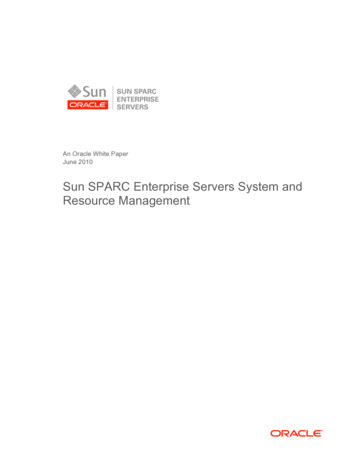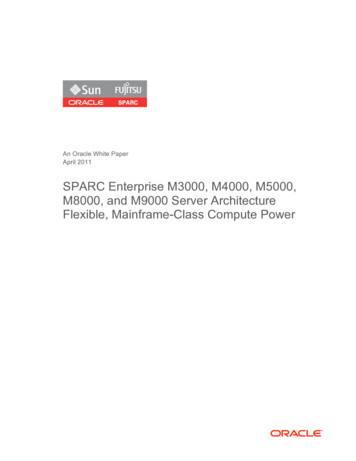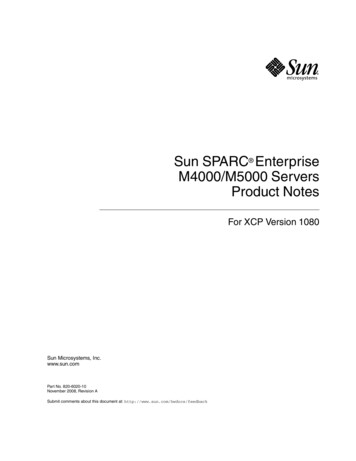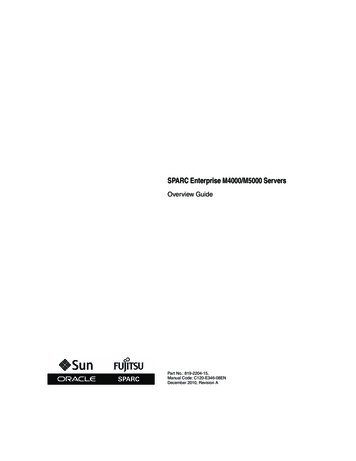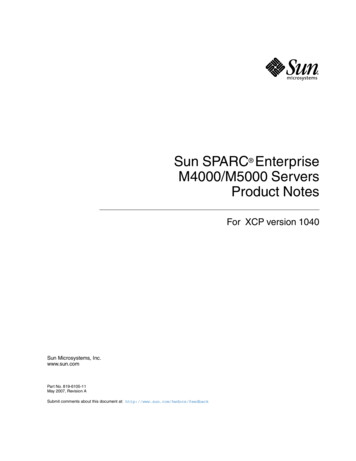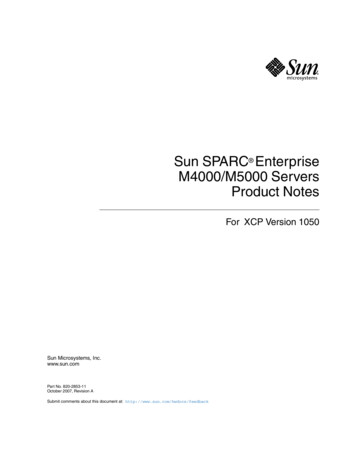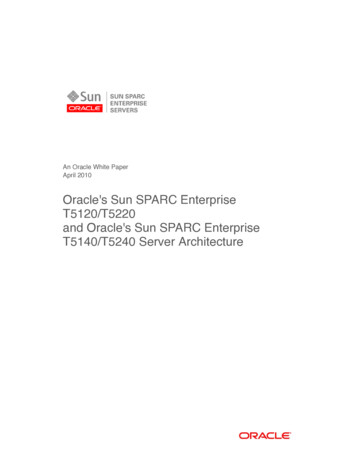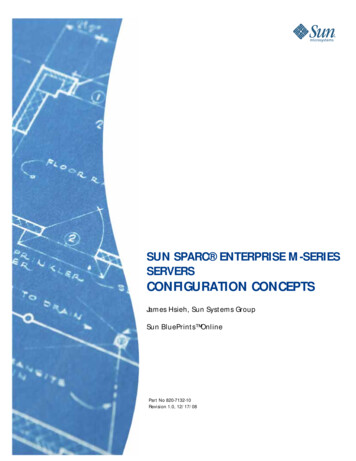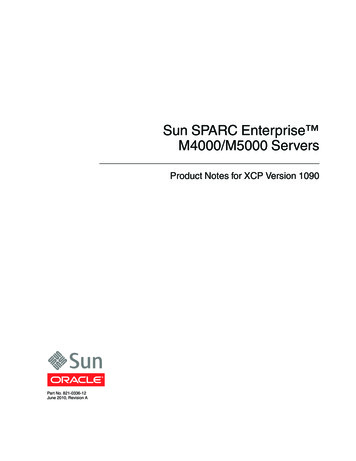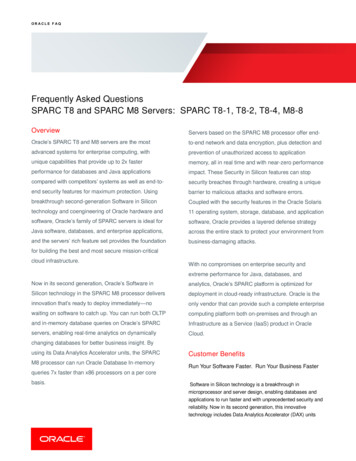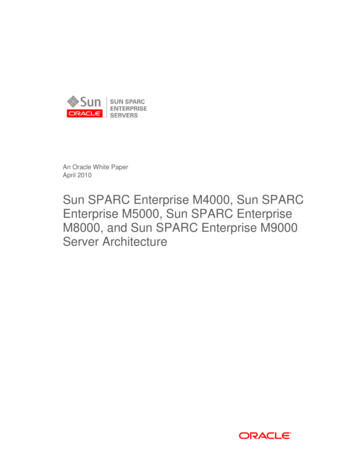
Transcription
An Oracle White PaperApril 2010Sun SPARC Enterprise M4000, Sun SPARCEnterprise M5000, Sun SPARC EnterpriseM8000, and Sun SPARC Enterprise M9000Server Architecture
Sun SPARC Enterprise M4000, M5000, M8000, and M9000 Server ArchitectureIntroduction . 1Flexible, Mainframe-Class Compute Power for the Data Center . 2Capabilities Overview. 3Meeting the Needs of Commercial and Scientific Computing . 4System Architecture . 5System Component Overview. 5Midrange Systems:Sun SPARC Enterprise M4000 and M5000 Servers. 12High-End Systems:Sun SPARC Enterprise M8000 and M9000 Servers. 14System Bus Architecture—Jupiter Interconnect. 17Interconnect Architecture . 17System Interconnect Reliability Features . 20Scalable Performance. 20SPARC64 VI and SPARC64 VII Processors. 21Next-Generation Processor Technology . 22Architecture of SPARC64 VI and SPARC64 VII Processors. 23I/O Subsystem. 33I/O Subsystem Architecture . 33Internal Peripherals . 35Sun External I/O Expansion Unit. 36Reliability, Availability, and Serviceability. 37Redundant and Hot-Swap Components . 37
Sun SPARC Enterprise M4000, M5000, M8000, and M9000 Server ArchitectureDynamic Domains . 38Dynamic Reconfiguration . 42Advanced Reliability Features. 42Error Detection, Diagnosis, and Recovery . 43System Management . 44Extended System Control Facility . 44Oracle Enterprise Manager Ops Center Software. 47Oracle Solaris 10. 48Observability and Performance. 48Availability . 49Security . 50Virtualization and Resource Management . 50Conclusion . 51
Sun SPARC Enterprise M4000, M5000, M8000, and M9000 Server ArchitectureIntroductionOrganizations rely on technology more than ever before. Today compute systems play acritical role in every function of every business, from product design to customer orderfulfillment. In many cases, success is dependent on continuous availability of IT services.Once required only in pockets of the data center, mainframe-class reliability andserviceability are now essential for systems throughout the enterprise. In addition,powering data center servers and keeping services running during a power outage aresignificant concerns.Although availability is a top priority, costs must also remain within budget andoperational familiarity must be maintained. New computing infrastructures must also helpprotect current investments in technology and training. To deliver networked services asefficiently and economically as possible, organizations look to maximize the use of everyIT asset through consolidation and virtualization strategies. As a result, modern IT systemrequirements reach far beyond simple compute capacity measures. Highly flexibleservers are required, with built-in virtualization capabilities and associated tools,technologies, and processes that work to optimize sever utilization. New computinginfrastructures must also help protect current investments in technology and training.Oracle’s Sun SPARC Enterprise M4000, Sun SPARC Enterprise M5000, Sun SPARCEnterprise M8000, and Sun SPARC Enterprise M9000 servers are highly reliable, easyto-manage, vertically scalable systems with many of the benefits of traditionalmainframes—without the associated cost, complexity, or vendor exclusivity. In fact, theseservers deliver mainframe-class system architecture at open systems prices.1
Sun SPARC Enterprise M4000, M5000, M8000, and M9000 Server ArchitectureFlexible, Mainframe-Class Compute Power for the Data CenterThe Sun SPARC Enterprise M4000, M5000, M8000, and M9000 servers (see Figure 1) delivermainframe-class system architecture at open systems prices. With symmetric multiprocessing(SMP) scalability from 1 to 64 processors, memory subsystems as large as 2 TB, and highthroughput I/O architectures, the Sun SPARC Enterprise M4000, M5000, M8000, and M9000servers easily perform the heavy lifting required by consolidated workloads. Furthermore, theseservers run Oracle Solaris 10 and include leading virtualization technologies. By offeringDynamic Domains, eXtended System Boards, Dynamic Reconfiguration, and Oracle SolarisContainers technology, the Sun SPARC Enterprise M4000, M5000, M8000, and M9000 serversbring sophisticated mainframe-class resource control to an open systems compute platform.Massive compute power, a resilient system architecture, flexible resource control features, andthe advanced capabilities of Oracle Solaris 10 combine in Sun SPARC Enterprise servers toprovide organizations a best-in-class enterprise platform. As an added benefit, the Sun SPARCEnterprise M4000, M5000, M8000, and M9000 servers also offer performance that is better thanthat of previous generations of Oracle’s Sun servers, with a clear upgrade path that protectsexisting investments in software, training, and data center practices. By taking advantage of SunSPARC Enterprise servers, IT organizations can create a more powerful infrastructure, optimizehardware utilization, and increase application availability—for lower operational cost and risk.Figure 1. Sun SPARC Enterprise M4000, M5000, M8000, and M9000 servers offer scalable power, reliability, and flexibility.2
Sun SPARC Enterprise M4000, M5000, M8000, and M9000 Server ArchitectureCapabilities OverviewThe members of the Sun SPARC Enterprise server family share many capabilities that fosterpower, reliability, and flexibility. The Sun SPARC Enterprise M4000, M5000, M8000, and M9000servers feature a balanced, highly scalable SMP design that utilizes the latest generation ofSPARC64 processors connected to memory and I/O by a high-speed, low-latency systeminterconnect that delivers exceptional throughput to applications. Also architected to reduceplanned and unplanned downtime, these servers include stellar reliability, availability, andserviceability capabilities to avoid outages and reduce recovery time. Design features such asadvanced CPU integration and data path integrity, memory extended error-correcting code(ECC), memory mirroring, end-to-end data protection, hot-swappable components, faultresilient power options, and hardware redundancy boost the reliability of these servers.The Sun SPARC Enterprise M4000, M5000, M8000, and M9000 servers also provide unmatchedconfiguration flexibility. As with other high-end servers from Oracle, administrators can useDynamic Domains to physically divide a single Sun SPARC Enterprise M4000, M5000, M8000,or M9000 servers into multiple electrically isolated partitions, each running independent instancesof Oracle Solaris. Hardware or software failures in one Dynamic Domain do not affectapplications running in other domains, unless the failed resource is shared across both domains.Dynamic Reconfiguration can then reallocate hardware resources among Dynamic Domains—without interrupting critical systems. Sun SPARC Enterprise M4000, M5000, M8000, and M9000servers advance resource control one step further with eXtended System Board (XSB)technology, supporting the allocation of subsystem board resources such as CPUs, memory, andI/O components to Dynamic Domains. The fine-grained resource control provided by XSBtechnology helps enterprises further optimize resource utilization.Adding even more value, the range of compute power offered by the Sun SPARC Enterpriseserver family provides the levels of vertical scalability required for many deployment classes,enabling organizations to match the right system to each task. The rack mount Sun SPARCEnterprise M4000 and M5000 servers are economical, powerful, and reliable servers that are wellsuited for midrange system requirements, and the Sun SPARC Enterprise M8000 and M9000servers deliver the massive processing power needed for high-end computing (see Table 1).3
Sun SPARC Enterprise M4000, M5000, M8000, and M9000 Server ArchitectureTABLE 1. CHARACTERISTICS OF THE SUN SPARC ENTERPRISE M4000, M5000, M8000, AND M9000 SERVERSSUN SPARCSUN SPARCSUN SPARCSUN SPARCSUN PRISEM4000 SERVERM5000 SERVERM8000 SERVERM9000-32 SERVERM9000-64 SERVEREnclosure 6 rack units 10 rack units 1 cabinet 1 cabinet 2 cabinetsSPARC64 VI 2.15 GHz 2.15 GHz 2.28 GHz with 2.28 GHz with 2.28 GHz withprocessors 5 MB L2 cache 5 MB L2 cache As many as 4dual-core chips As many as 8dual-core chips5 MB L2 Cache5 MB L2 cache5 MB L2 cache 2.4 GHz with 6 2.4 GHz with 6 2.4 GHz withMB L2 cacheMB L2 cache As many as 16 As many as 32 As many as 64dual-core chipsdual-core chipsdual-core chips6 MB L2 cacheSPARC64 2.4 GHz 2.4 GHz 2.52 GHz 2.52 GHz 2.52 GHzVII 5 MB L2 cache 5 MB L2 cache 6 MB L2 cache 6 MB L2 cache 6 MB L2 cache As many as 4 As many as 8 As many as 16 As many as 32 As many as pschipschipschipschipsprocessors Up to 128 GB Up to 256 GB Up to 512 GB Up to 1 TB Up to 2 TB 32 DIMM slots 64 DIMM slots 128 DIMM slots 256 DIMM slots 512 DIMM slotsInternal I/O 4 PCIe 8 PCIe 32 PCIe 64 PCIe 128 PCIeslots 1 PCI 2 PCI As many as 8 As many as 16 As many as 16MemoryeXtendedExternal I/O 1 or 2 unitschassisInternalstorageeXtended As many as 4units Serial-attachedSCSI 1 or 2 drives Serial-attachedSCSI As many as 4drivesDynamic 1 or 2 As many as 4units Serial-attachedSCSI As many as 16drives As many as 16units Serial-attachedSCSI As many as 32drives As many as 24units Serial-attachedSCSI As many as 64drives As many as 24domainsMeeting the Needs of Commercial and Scientific ComputingSuiting a wide range of computing environments, Sun SPARC Enterprise M4000, M5000,M8000, and M9000 servers provide the availability features needed to support commercialcomputing workloads along with the raw performance demanded by high-performancecomputing (HPC), as shown in Table 2.4
Sun SPARC Enterprise M4000, M5000, M8000, and M9000 Server ArchitectureTABLE 2. ENTERPRISE APPLICATIONS THAT CAN BENEFIT FROM THE POWER AND FLEXIBILITY OF SUN SPARCENTERPRISE SERVERSSUN SPARC ENTERPRISE M4000 AND M5000 SERVERSSUN SPARC ENTERPRISE M8000 AND M9000 SERVERS Server consolidation Server consolidation Business processing (ERP, CRM, OLTP, batch) Business processing (ERP, CRM, OLTP, batch) Database Database Decision support Decision support Data mart Data warehouses Web services IT infrastructure System and network management Application serving Application development Compute-intensive scientific engineering Scientific engineeringSystem ArchitectureContinually challenged by growing workloads and demands to do more with less, ITorganizations realize that meeting processing requirements with fewer, more powerful systemscan provide economic advantages. In Sun SPARC Enterprise M4000, M5000, M8000, andM9000 servers, the interconnect, processors, memory subsystem, and I/O subsystem worktogether to create a scalable, high-performance platform ready to address server consolidationneeds. By taking advantage of these servers, organizations can load multiple projects onto asingle platform and accelerate application execution at lower costs.System Component OverviewThe design of Sun SPARC Enterprise M4000, M5000, M8000, and M9000 servers focusesspecifically on delivering high reliability, outstanding performance, and true SMP scalability. Thecharacteristics and capabilities of every subsystem within these servers work toward this goal. Ahigh-bandwidth system bus, powerful SPARC64 VI and SPARC64 VII processors, densememory options, and fast PCI Express (PCIe) and PCI eXtended (PCI-X) expansion slotscombine within these servers to deliver high levels of uptime and throughput as well asdependable scaling for enterprise applications.System InterconnectBased on mainframe technology, the Jupiter system interconnect fosters high levels ofperformance, scalability, and reliability for Sun SPARC Enterprise M4000, M5000, M8000, andM9000 servers. Multiple system controllers and crossbar units provide point-to-pointconnections between CPU, memory, and I/O subsystems. Offering more than one bus route5
Sun SPARC Enterprise M4000, M5000, M8000, and M9000 Server Architecturebetween components enhances performance and enables system operation to continue in theevent of a faulty switch. Indeed, the system interconnect used in these servers delivers as much as737 GB/sec of peak bandwidth, offering substantially more system throughput than the previousgeneration of Oracle’s high-end Sun servers. Additional technical details of the systeminterconnect on each Sun SPARC Enterprise server can be found in the “System BusArchitecture—Jupiter Interconnect” section of this paper.The SPARC64 VI and SPARC64 VII ProcessorsThe Sun SPARC Enterprise M4000, M5000, M8000, and M9000 servers utilize SPARC64 VI andSPARC64 VII processors developed by Fujitsu. The design of the multicore, multithreadedSPARC64 VI and SPARC64 VII processors is based on several decades of experience in creatingmainframe systems that achieve high levels of reliability and performance. The SPARC64 VIdual-core, multithreaded processor takes advantage of 90 nm technology, whereas the SPARC64VII processor provides a quad-core implementation with a faster clock speed and a reduction insize, using 65 nm fabrication. Both processors execute at a power consumption level below 150watts. Moreover, Sun SPARC Enterprise M4000, M5000, M8000, and M9000 servers increaseflexibility and maintain investment protection, by supporting configurations that mix SPARC64VI and SPARC64 VII processors within the same system board. Additional technical detailsabout the SPARC64 processor are found in the “SPARC64 VI and SPARC VII Processors”section of this paper.MemoryThe memory subsystem of the Sun SPARC Enterprise M4000, M5000, M8000, and M9000servers increases the scalability and throughput of these systems. In fact, the Sun SPARCEnterprise M9000 server accommodates up to 2 TB of memory. The Sun SPARC EnterpriseM4000, M5000, M8000, and M9000 servers use Fully Buffered Dual Inline Memory Module (FBDIMM) technology with eight-way memory interleave to enhance system performance. Althoughmultiple DIMM sizes are not supported within a single bank, DIMM capacities can vary acrosssystem boards. Available DIMM sizes include 1 GB, 2 GB, and 4 GB densities. Further detailsabout the memory subsystems are presented in Table 3.6
Sun SPARC Enterprise M4000, M5000, M8000, and M9000 Server ArchitectureTABLE 3. MEMORY SUBSYSTEM SPECIFICATIONSSUN SPARCSUN SPARCSUN SPARCSUN SPARCSUN SPARCENTERPRISEENTERPRISEENTERPRISEENTERPRISE M9000-32ENTERPRISE M9000-64M4000 SERVERM5000 SERVERM8000 SERVERSERVERSERVER128 GB256 GB512 GB1 TB2 TBDIMM slots3264As many as 128As many as 256As many as 512Bank size4 DIMMs4 DIMMs4 DIMMs4 DIMMs4 DIMMsNumber of816As many as 16As many as 32As many as 64MaximummemorycapacitybanksBeyond performance, the memory subsystems of the Sun SPARC Enterprise M4000, M5000,M8000, and M9000 servers are built with reliability in mind. ECC protection is implemented fordata stored in main memory, and the following advanced features foster early diagnosis and faultisolation that preserve system integrity and raise application availability. Memory patrol. Memory patrol periodically scans memory for errors. This proactive functionprevents the use of faulty areas of memory so that they cannot cause system or applicationerrors, improving system reliability. Memory Extended ECC. The memory extended ECC function of these servers providessingle-bit error correction, supporting continuous processing despite events such as burst readerrors that are sometimes caused by memory device failures. This feature is similar to IBM’sChipkill technology. Memory mirroring. Memory mirroring is an optional, high-availability feature appropriate forexecution of applications with the most-stringent availability requirements. When memorymirroring mode is enabled on Sun SPARC Enterprise M4000, M5000, M8000, and M9000servers, the memory subsystem duplicates the data on write and compares the data on readwith each side of the memory mirror. If errors occur at the bus or DIMM level, normal dataprocessing will continue through the other memory bus and alternative DIMM set. In SunSPARC Enterprise M4000 and M5000 servers, memory is mirrored within the same memorymodule, with the common memory address controller (MAC) ASIC (see Figures 2 and 3).7
Sun SPARC Enterprise M4000, M5000, M8000, and M9000 Server ArchitectureFigure 2. This diagram depicts the Sun SPARC Enterprise M4000 server memory mirroring architecture.Figure 3. This diagram depicts the Sun SPARC Enterprise M5000 server memory mirroring architecture.On the Sun SPARC Enterprise M8000 and M9000 servers, memory is mirrored across adjacentMAC ASICs to increase reliability (see Figure 4). However, in a Quad-XSB configuration, pairedDIMMs are split across various Sun SPARC Enterprise M8000 and M9000 Quad-XSBs. As such,memory mirroring is incompatible with the optional configuration of Quad-XSBs on SunSPARC Enterprise high-end server system boards.8
Sun SPARC Enterprise M4000, M5000, M8000, and M9000 Server ArchitectureFigure 4. This diagram depicts the Sun SPARC Enterprise M8000 and M9000 server memory mirroring architecture.System ClockAlthough the implementation of the system clock varies with the member of the Sun SPARCEnterprise server family, each server is engineered with reliability in mind. In particular, the SunSPARC Enterprise M9000 server clock chip is built with redundant internal components. TheSun SPARC Enterprise M9000 server also implements two sources of clock signal, and a dualsignal source-synchronous line exists between the clock chip and the system boards, enabling thesystem to restart if one route fails. Further enhancing availability and easing maintenance, SunSPARC Enterprise M9000 server provides for configuration of a redundant clock control unit.PCI Express and PCI-eXtended TechnologySun SPARC Enterprise servers use a PCI bus to provide high-speed data transfer within the I/Osubsystem. In order to support PCIe expansion cards, Sun SPARC Enterprise M4000, M5000,M8000, and M9000 servers use a PCIe physical layer (PCIe PHY) ASIC to manage theimplementation of the PCIe protocol. PCIe technology doubles the peak data transfer rates of9
Sun SPARC Enterprise M4000, M5000, M8000, and M9000 Server Architectureoriginal PCI technology and reaches 2.5 Gb/sec of throughput. In fact, PCIe was developed toaccommodate high-speed interconnects such as Fibre Channel, InfiniBand, and GigabitEthernet. The Sun SPARC Enterprise M4000, M5000, M8000, and M9000 servers also supportPCI-X expansion cards for fast access to external devices. PCI-X is backward-compatible withexisting PCI cards but increases bandwidth, supporting data transfer of up to 1 GB/sec for 64bit devices. Additional technical details of Sun SPARC Enterprise server I/O subsystems can befound in the “I/O Subsystem” section.Service Processor—Extended System Control FacilitySimplifying management of compute systems leads to higher availability levels for hostedapplications. With this in mind, midrange and high-end models of Sun SPARC Enterprise serversinclude an eXtended System Control Facility (XSCF), which consists of a dedicated processorthat is independent of the server and runs the XSCF Control Package (XCP) to provide remotemonitoring and management capabilities. This service processor regularly monitorsenvironmental sensors, provides advanced warning of potential error conditions, and executesproactive system maintenance procedures as necessary. Indeed, while power is supplied to theserver, the XSCF constantly monitors the platform, even if the system is inactive. The XCPfacilitates Dynamic Domain configuration; audit administration; hardware control capabilities;hardware status monitoring, reporting, and handling; automatic diagnosis and domain recovery;capacity-on-demand operations; and XSCF failover services. Additional technical details aboutthe XSCF and the XCP are found in the “System Management” section.Power and CoolingSun SPARC Enterprise M4000, M5000, M8000, and M9000 servers use separate modules forpower and cooling. Sensors placed throughout the system measure temperatures on processorsand key ASICS as well as the ambient temperature at several locations. Hardware redundancy inthe power and cooling subsystems, combined with environmental monitoring, keep serversoperating even under power or fan fault conditions.Fan UnitFully redundant, hot-swap fans function as the primary cooling system for Sun SPARCEnterprise M4000, M5000, M8000, and M9000 servers (see Table 4 and Table 5). If a single fanfails, the XSCF will detect the failure and switch the remaining fans to high-speed operation tocompensate for the reduced airflow. The Sun SPARC Enterprise M4000, M5000, M8000, andM9000 servers can operate normally under these conditions, allowing ample time to service thefailed unit. Replacement of fan units can occur without interruption of application processing.10
Sun SPARC Enterprise M4000, M5000, M8000, and M9000 Server ArchitecturePower SupplyThe use of redundant power supplies and power cords adds to the fault resilience of the SunSPARC Enterprise M4000, M5000, M8000, and M9000 servers (see Table 4 and Table 5).Redundant hot-swap power supplies deliver power, helping support continued server operationeven if a power supply fails. Because the power units are hot-swappable, removal andreplacement can occur while the system continues to operate.As an option, the Sun SPARC Enterprise M8000 and M9000 servers can be ordered with a threephase power supply unit and a corresponding server cabinet. Models with a three-phase powersupply permit two configurations: (1) a star connection that connects a neutral line and eachphase and (2) a delta connection that connects each phase.TABLE 4. POWER AND COOLING SPECIFICATIONS FOR MIDRANGE SERVERSFan unitsPower suppliesPower cordsSUN SPARC ENTERPRISE M4000 SERVERSUN SPARC ENTERPRISE M5000 SERVER 4 fan units 4 fan units Two 172 mm fans Four 172 mm fans Two 60 mm fans 2 fan groups, each containing 2 fan units 1 redundant fan of each type 1 redundant fan per fan group 2,350 W 4,590 W 2 units 4 units 1 1 redundant 2 2 redundant Single-phase Single-phase 2 power cables 4 power cables 1 1 redundant power cables 2 2 redundant power cablesTABLE 5. POWER AND COOLING SPECIFICATIONS FOR HIGH-END SERVERSFan unitsSUN SPARC ENTERPRISESUN SPARC ENTERPRISESUN SPARC ENTERPRISEM8000 SERVERM9000-32 SERVERM9000-64 SERVER 12 fan units 16 fan units 32 fan units Four 172 mm fans Sixteen 172 mm fans Thirty-two 172 mm fans Eight 60 mm fans N 1 redundant N 1 redundant 10,500 W 21,300 W 42,600 W 9 units 15 units 30 units N 1 redundant N 1 redundant N 1 redundant N 1 redundantPower supplies11
Sun SPARC Enterprise M4000, M5000, M8000, and M9000 Server ArchitectureOptionsPower cords Single-phase Single-phase Single-phase 3-phase 3-phase 3-phase Dual-grid Dual-grid Dual-grid 3 power cables (single- 5 power cables (single-feed) 10 power cables (single-feed) 6 power cables (dual-feed) 2 power cables (3-phase) 10 power cables (dual-feed) 2 power cables (3-phase)feed) 20 power cables (dualfeed) 4 power cables (3-phase)Optional Dual Power FeedOrganizations can control most factors within the data center, but utility outages are oftenunexpected. The consequences of loss of electrical power can be devastating to IT operations. Inorder to help reduce the impact of such incidents, the Sun SPARC Enterprise M4000, M5000,M8000, and M9000 servers are dual-power-feed-capable. The AC power subsystem in theseservers is completely duplicated, providing optional reception of power from two external andindependent AC power sources. The use of a dual power feed and redundant power supplies canincrease system availability, because server operations can remain unaffected even after a singlepower grid failure.Operator PanelMidrange and high-end models of Sun SPARC Enterprise servers feature an operator panel fordisplaying server status, storing server identification and user setting information, changingbetween operational and maintenance modes, and turning on power supplies for domains.During server startup, the front panel LED status indicators verify XSCF and server operation.Figure 5. This figure shows the elements of the Sun SPARC Enterprise M4000, M5000, M8000, and M9000 servers’ operator panel.Midrange Systems—Sun SPARC Enterprise M4000 and M5000 ServersThe Sun SPARC Enterprise M4000 and M5000 servers are economical, high-power computeplatforms with enterprise-class features. These midrange servers are designed to reliably carrydata center workloads that support core business operations.12
Sun SPARC Enterprise M4000, M5000, M8000, and M9000 Server ArchitectureSun SPARC Enterprise M4000 ServerThe Sun SPARC Enterprise M4000 server enclosure measures six rack units (6U) and supportsas many as four processor chips, 128 GB of memory, and one or two Dynamic Domains. Inaddition, the Sun SPARC Enterprise M4000 server features four short internal PCIe slots andone short internal PCI-X slot as well as two disk drives, one DVD drive, and an optional DATtape drive. Two power supplies and four fan units power and cool the Sun SPARC EnterpriseM4000 server.Figure 6. This diagram shows details of the Sun SPARC Enterprise M4000 server enclosure.Sun SPARC Enterprise M5000 ServerThe Sun SPARC Enterprise M5000 server enclosure measures 10U and supports as many aseight processor chips, 256 GB of memory, and as many as four Dynamic Domains. In addition,the Sun SPARC Enterprise M5000 server features eight short internal PCIe and two shortinternal PCI-X slots as well as four disk drives, one DVD drive, and an optional DAT tape drive.Four power supplies and four fan units power and cool the server.13
Sun SPARC Enterprise M4000, M5000, M8000, and M9000 Server ArchitectureFigure 7. This diagram shows details of the Sun SPARC Enterprise M5000 server enclosure.High-End Systems—Sun SPARC Enterprise M8000 and M9000 ServersHigh-end Sun SPARC Enterprise servers are designed to deliver outstanding performance foreven the most challenging workloads. By merging mainframe reliability, advanced performancetechnology often used in supercomputers, and an open systems environment, these servers helporganizations create reliable, high-throughput, flexible solutions.Sun SPARC Enterprise M8000 ServerThe Sun SPARC Enterprise M8000 server is mounted in an enterprise system cabinet andsupports as many as four CPU memory units (CMUs) and four I/O units (IOUs). Fullyconfigured, the Sun SPARC Enterprise M8000 server houses 16 processor chips, 512 GB ofmemory, and 32 short internal PCIe slots and can be divided into 16 Dynamic Domains. Inaddition, the Sun SPARC Enterprise M8000 server supports as many as 16 disk drives, 1 DVDdrive, and an optional DAT tape drive. Nine power supplies and 12 fan units power and cool theSun SPARC Enterprise M8000 server.14
Sun SPARC Enterprise M4000, M5000, M8000, and M9000 Server ArchitectureFigure 8. This diagram shows details of the Sun SPARC Enterprise M8000 server enclosure.Sun SPARC Enterprise M9000-32 ServersThe Sun SPARC Enterprise M9000-32 server mounts in an enterprise system cabinet andsupports as many as eight CMUs and eight IOUs. Fully configured, the Sun SPARC EnterpriseM9000-32 server houses 32 processor chips, 1 TB of memory, and 64 short internal PCIe slotsand can be divided into 24 Dynamic Domains. In addition, the Sun SPARC Enterprise M900032 server supports as many as 32 disk drives, one DVD drive, and an optional DAT tape drive.Power and cooling for Sun SPARC Enterprise M9000-32 servers are provided by 15 powersupplies and 16 fan units.15
Sun SPARC Enterprise M4000, M5000, M8000, and M9000 Server ArchitectureFigure 9. This diagram shows details of the Sun SPARC Enterprise M9000-32 server enclosure.Sun SPARC Enterprise M9000-64 ServerAn expansion cabinet can be added to an existing base cabinet to create the Sun SPARCEnterprise M9000-64 server, supporting as many as 16 CMUs and 16 IOUs. Fully configured,the Sun SPARC Enterprise M9000-64 server houses 64 processor chips, 2 TB of memory, and128 short internal PCIe slots and can be divide
The Sun SPARC Enterprise M4000, M5000, M8000, and M9000 servers (see Figure 1) deliver mainframe-class system architecture at open systems prices. With symmetric multiprocessing (SMP) scalability from 1 to 64 processors, memory subsystems as large as 2 TB, and high-
